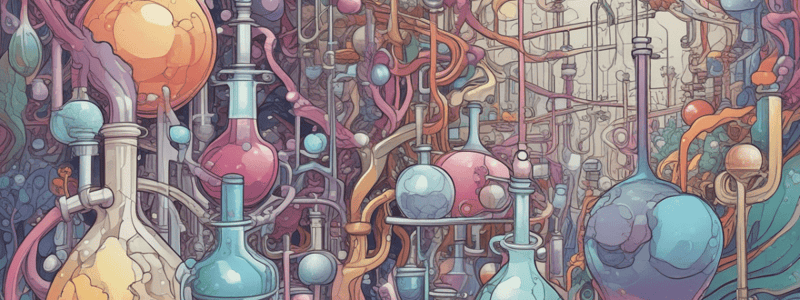Podcast
Questions and Answers
What is the reaction outcome of furan with iodine at room temperature?
What is the reaction outcome of furan with iodine at room temperature?
- Polyhalogenated products are formed
- Monohalogenated products are formed
- Furan decomposes
- No reaction occurs (correct)
What is required for the formation of monobromo- and monochloro-furans?
What is required for the formation of monobromo- and monochloro-furans?
- Presence of a catalyst
- High temperature
- Milder conditions (correct)
- Harsh conditions
What is the product of bromination of furan by bromine in dimethylformamide at room temperature?
What is the product of bromination of furan by bromine in dimethylformamide at room temperature?
- Monochloro-furans
- Polybromo-furans
- 2-Bromo- or 2,5-dibromo-furans (correct)
- 2,5-Dibromo-furans
What is the role of dioxane in the bromination of furan?
What is the role of dioxane in the bromination of furan?
What is the mechanism involved in the bromination of furan substituted with an electron-withdrawing group at the position-2?
What is the mechanism involved in the bromination of furan substituted with an electron-withdrawing group at the position-2?
What is the product of bromination of furan substituted with an electron-withdrawing group at the position-2?
What is the product of bromination of furan substituted with an electron-withdrawing group at the position-2?
What is the order of reactivity in five-membered heterocycles?
What is the order of reactivity in five-membered heterocycles?
Why is pyrrole more reactive towards electrophiles than furan?
Why is pyrrole more reactive towards electrophiles than furan?
What is the reason for the less reactive nature of furan compared to pyrrole?
What is the reason for the less reactive nature of furan compared to pyrrole?
Why is thiophene less reactive than furan towards electrophiles?
Why is thiophene less reactive than furan towards electrophiles?
What is the order of aromaticity in five-membered heterocycles?
What is the order of aromaticity in five-membered heterocycles?
Why is nitrogen more effective in stabilizing the transition state than oxygen?
Why is nitrogen more effective in stabilizing the transition state than oxygen?
What is the reason for the greater reactivity of pyrrole towards electrophiles?
What is the reason for the greater reactivity of pyrrole towards electrophiles?
Why is thiophene less reactive than pyrrole towards electrophiles?
Why is thiophene less reactive than pyrrole towards electrophiles?
What is the effect of electron-releasing substituents at C-2 position on the incoming electrophile?
What is the effect of electron-releasing substituents at C-2 position on the incoming electrophile?
What is the effect of strongly activating substituents at C-2 position?
What is the effect of strongly activating substituents at C-2 position?
What is the effect of electron-withdrawing substituents at C-2 position?
What is the effect of electron-withdrawing substituents at C-2 position?
What is the reason for the formation of 2,5-disubstituted furan?
What is the reason for the formation of 2,5-disubstituted furan?
What is the effect of weakly electron-releasing substituents at C-2 position?
What is the effect of weakly electron-releasing substituents at C-2 position?
What is the competing effect in the presence of electron-withdrawing substituents at C-2 position?
What is the competing effect in the presence of electron-withdrawing substituents at C-2 position?
What is similar to the effect of electron-releasing substituents at C-2 position?
What is similar to the effect of electron-releasing substituents at C-2 position?
What is the effect of electron-withdrawing substituents at C-2 position on the incoming electrophile?
What is the effect of electron-withdrawing substituents at C-2 position on the incoming electrophile?
What is the product of the oxidation of thiophene by peracids?
What is the product of the oxidation of thiophene by peracids?
What happens when thiophene is reduced under certain conditions?
What happens when thiophene is reduced under certain conditions?
What is the role of Raney Ni/Hy in the oxidation of thiophene?
What is the role of Raney Ni/Hy in the oxidation of thiophene?
What is the outcome of the electrophilic addition of bromine in presence of methanol?
What is the outcome of the electrophilic addition of bromine in presence of methanol?
What is the limitation of reducing thiophene?
What is the limitation of reducing thiophene?
What is the process involved in the formation of 2-Methyltetrahydrofuran?
What is the process involved in the formation of 2-Methyltetrahydrofuran?
What is the reactant in the formation of 2,5-Dihydro-2,5-dimethoxyfuran?
What is the reactant in the formation of 2,5-Dihydro-2,5-dimethoxyfuran?
What is the catalyst used in the formation of 2,5-Dihydro-2,5-dimethoxyfuran?
What is the catalyst used in the formation of 2,5-Dihydro-2,5-dimethoxyfuran?
Why is benzene less reactive towards electrophiles than five-membered heterocycles?
Why is benzene less reactive towards electrophiles than five-membered heterocycles?
What is the order of aromaticity among benzene, thiophene, furan, and pyrrole?
What is the order of aromaticity among benzene, thiophene, furan, and pyrrole?
Why does furan tend to give addition products instead of substitution products?
Why does furan tend to give addition products instead of substitution products?
What is the correct order of reactivity in electrophilic substitution?
What is the correct order of reactivity in electrophilic substitution?
Why are the 2 & 5 positions in pyrrole more reactive than the 3 & 4 positions?
Why are the 2 & 5 positions in pyrrole more reactive than the 3 & 4 positions?
What is the main reason for the difference in reactivity between benzene and five-membered heterocycles?
What is the main reason for the difference in reactivity between benzene and five-membered heterocycles?
What is the role of the transition state in determining the reactivity of benzene and five-membered heterocycles?
What is the role of the transition state in determining the reactivity of benzene and five-membered heterocycles?
Why is nitration with a mild nitrating agent possible only in the furan nucleus at C-2?
Why is nitration with a mild nitrating agent possible only in the furan nucleus at C-2?
The acylation of furan results in exclusively 2-acylfuran with acid anhydrides in the presence of mild catalysts.
The acylation of furan results in exclusively 2-acylfuran with acid anhydrides in the presence of mild catalysts.
Trifluoroacetic anhydride requires a catalyst for the acylation of furan.
Trifluoroacetic anhydride requires a catalyst for the acylation of furan.
Friedel-Crafts acylation can be performed with Ac2O-SnCl3.
Friedel-Crafts acylation can be performed with Ac2O-SnCl3.
Phosphoric acid is a strong catalyst for the acylation of furan.
Phosphoric acid is a strong catalyst for the acylation of furan.
Boron trifluoride etherate is a catalyst used in the Friedel-Crafts acylation of furan.
Boron trifluoride etherate is a catalyst used in the Friedel-Crafts acylation of furan.
The acylation of furan can only be performed with trifluoroacetic anhydride.
The acylation of furan can only be performed with trifluoroacetic anhydride.
Furan can be acylated with acid anhydrides in the absence of a catalyst.
Furan can be acylated with acid anhydrides in the absence of a catalyst.
The Friedel-Crafts acylation of furan results in a mixture of 2-acylfuran and 3-acylfuran.
The Friedel-Crafts acylation of furan results in a mixture of 2-acylfuran and 3-acylfuran.
Electron-releasing substituents at C-2 position tend to direct incoming electrophile to C-3 position.
Electron-releasing substituents at C-2 position tend to direct incoming electrophile to C-3 position.
The presence of strongly activating substituents (-OCH3, -NHCOCH3) at C-2 position causes substitution to occur at C-5.
The presence of strongly activating substituents (-OCH3, -NHCOCH3) at C-2 position causes substitution to occur at C-5.
Electron-withdrawing substituents at C-2 position cause substitution to occur at C-3.
Electron-withdrawing substituents at C-2 position cause substitution to occur at C-3.
The -directing effect of the heteroatom always dominates the directing effect of the substituent in furan.
The -directing effect of the heteroatom always dominates the directing effect of the substituent in furan.
The formation of 2,5-disubstituted furan is rationalized by the most powerful directing effect of sulfur in furan.
The formation of 2,5-disubstituted furan is rationalized by the most powerful directing effect of sulfur in furan.
Weakly electron-releasing substituents (-CI, -CH3) at C-2 position cause substitution to occur at C-3.
Weakly electron-releasing substituents (-CI, -CH3) at C-2 position cause substitution to occur at C-3.
The effect of electron-releasing substituents at C-2 position is similar to the meta-directing effect in benzene.
The effect of electron-releasing substituents at C-2 position is similar to the meta-directing effect in benzene.
The directing effect of electron-withdrawing substituents at C-2 position is more powerful than that of the heteroatom in furan.
The directing effect of electron-withdrawing substituents at C-2 position is more powerful than that of the heteroatom in furan.
Electron-releasing substituents at C-3 reinforce the meta-directing effect of ring heteroatom.
Electron-releasing substituents at C-3 reinforce the meta-directing effect of ring heteroatom.
Electron-withdrawing substituents at C-3 have a similar effect to the ortho-directing effect in benzene.
Electron-withdrawing substituents at C-3 have a similar effect to the ortho-directing effect in benzene.
The reactivity of five-membered heterocycles towards electrophiles depends only on the electron availability on the ring carbon atoms.
The reactivity of five-membered heterocycles towards electrophiles depends only on the electron availability on the ring carbon atoms.
Furan is more reactive towards electrophiles than thiophene.
Furan is more reactive towards electrophiles than thiophene.
The presence of electron-releasing substituents at C-3 restricts the substitution at C-2.
The presence of electron-releasing substituents at C-3 restricts the substitution at C-2.
Electron-withdrawing substituents at C-3 direct the incoming electrophile to C-2.
Electron-withdrawing substituents at C-3 direct the incoming electrophile to C-2.
The reactivity of five-membered heterocycles towards electrophiles is independent of the electron availability on the ring carbon atoms.
The reactivity of five-membered heterocycles towards electrophiles is independent of the electron availability on the ring carbon atoms.
The combined effect of meta-directing effect of the substituent and the directing effect of the heteroatom causes substitution to occur at C-2.
The combined effect of meta-directing effect of the substituent and the directing effect of the heteroatom causes substitution to occur at C-2.
Pyrrole is less reactive towards electrophiles than furan.
Pyrrole is less reactive towards electrophiles than furan.
Thiophene is more reactive than furan towards electrophiles.
Thiophene is more reactive than furan towards electrophiles.
Benzene is more reactive towards electrophiles than five-membered heterocycles.
Benzene is more reactive towards electrophiles than five-membered heterocycles.
The order of aromaticity is pyrrole > thiophene > furan > benzene.
The order of aromaticity is pyrrole > thiophene > furan > benzene.
Furan is more reactive towards electrophiles than pyrrole at C-2.
Furan is more reactive towards electrophiles than pyrrole at C-2.
The +M effect of sulfur is greater than that of oxygen.
The +M effect of sulfur is greater than that of oxygen.
Nitrogen is less effective in stabilizing the transition state than oxygen.
Nitrogen is less effective in stabilizing the transition state than oxygen.
Thiophene is more aromatic than furan.
Thiophene is more aromatic than furan.
Thiophene is more reactive than furan towards electrophiles.
Thiophene is more reactive than furan towards electrophiles.
The Diels-Alder reaction of thiophene with maleic anhydride requires mild conditions.
The Diels-Alder reaction of thiophene with maleic anhydride requires mild conditions.
Furan can be nitrated with concentrated nitric acid.
Furan can be nitrated with concentrated nitric acid.
The order of reactivity in the Diels-Alder reaction is furan > pyrrole > thiophene.
The order of reactivity in the Diels-Alder reaction is furan > pyrrole > thiophene.
The intermediate 2,5-addition product can be isolated in the nitration of furan.
The intermediate 2,5-addition product can be isolated in the nitration of furan.
Acetyl nitrate is a mild nitrating agent.
Acetyl nitrate is a mild nitrating agent.
Thiophene is more aromatic than pyrrole.
Thiophene is more aromatic than pyrrole.
Raney Ni/H is used in the reduction of thiophene.
Raney Ni/H is used in the reduction of thiophene.
Study Notes
Halogenation of Furan
- Furan reacts vigorously with chlorine and bromine at room temperature to give polyhalogenated products.
- Furan reacts with bromine in dimethylformamide at room temperature to produce 2-bromo-furan or 2,5-dibromo-furan.
- Bromination of furan by bromine in dioxane-dibromide at -5°C gives 2-bromo-furan.
Mechanism of Bromination
- Bromination of furan involves an electrophilic substitution mechanism.
Effect of Electron-Releasing Substituents at C-2
- Electron-releasing substituents at C-2 position direct incoming electrophile to C-5 position.
- Weakly electron-releasing substituents (-Cl, -CH3) at C-2 position tend to direct incoming electrophile to C-5 position.
- Strongly activating substituents (-OCH3, -NHCOCH3) may lead to substitution at C-3 due to the ortho-effect of electron-releasing substituents.
Effect of Electron-Withdrawing Substituents at C-2
- Electron-withdrawing substituents at C-2 position cause substitution at C-4 due to directing influence of the substituent.
- The directing effect of substituent competes with the -directing effect of heteroatom, causing substitution to occur at C-5.
Reactivity Comparison with Benzene
- The order of reactivity in five-membered heterocycles is: pyrrole > furan > thiophene > benzene.
- The order of aromaticity is: benzene > thiophene > furan > pyrrole.
- Furan is less reactive than pyrrole towards electrophiles due to oxygen being more electronegative than nitrogen.
- Thiophene is less reactive than furan towards electrophiles due to sulfur being less electronegative than oxygen.
Synthesis of Furan and Thiophene
- Furan and thiophene can be synthesized from dicarbonyl compounds in the presence of a weak base.
Addition Reactions
- Furan undergoes electrophilic addition reactions, such as oxidation with bromine in methanol to produce 2,5-dihydro-2,5-dimethoxyfuran.
Thiophene Oxidation and Reduction
- Thiophene can be oxidized by peracids to thiophene-1-oxide and 2-hydroxythiophene oxide.
- Thiophene cannot be reduced under normal conditions due to sulfur poisoning the catalyst, but partial reduction can occur with metals in acidic medium.
Friedel-Crafts Acylation
- Furan can be acylated with acid anhydrides in the presence of mild catalysts such as phosphoric acid or boron trifluoride etherate to form exclusively 2-acylfuran.
- Acylation can also be performed with Ac2O-SnCl4, although trifluoroacetic anhydride does not require a catalyst.
Effect of Electron-Releasing Substituents at C-2
- Electron-releasing substituents at C-2 position direct the incoming electrophile to C-5 position.
- Weakly electron-releasing substituents (-Cl, -CH3) tend to direct the electrophile to C-5 position.
- Strongly activating substituents (-OCH3, -NHCOCH3) may cause substitution to occur at C-3 due to the ortho-effect of electron-releasing substituents.
Effect of Electron-Withdrawing Substituents at C-2
- Electron-withdrawing substituents at C-2 cause substitution at C-4 due to the directing influence of the substituent.
- The directing effect of the substituent competes with the -directing effect of the heteroatom, which may cause substitution to occur at C-5.
Effect of Electron-Releasing Substituents at C-3
- Electron-releasing substituents at C-3 reinforce the -directing effect of the ring heteroatom with substitution at C-2.
- If the electron-releasing substituent is alkyl, the reactivity of -positions (C-2 and C-5) does not differ appreciably.
- Sterically hindered alkyl groups or incoming electrophiles may restrict substitution at C-2 and cause it to occur at C-5.
Effect of Electron-Withdrawing Substituents at C-3
- Electron-withdrawing substituents at C-3 have a similar effect to meta-directing substituents in benzene.
- The combined effect of both the meta-directing effect of the substituent and the -directing effect of the heteroatom causes substitution to occur at C-5 most favourably.
Furan and Thiophene
- The reactivity of five-membered heterocycles towards electrophiles depends on the electron availability on the ring carbon atoms and the mesomerically electron release from the heteroatom.
- The order of reactivity in five-membered heterocycles is: pyrrole > furan > thiophene > benzene.
- The order of aromaticity is: benzene > thiophene > furan > pyrrole.
Diels-Alder Reaction
- The reaction of thiophene with maleic anhydride requires more drastic conditions than in the case of furan and pyrrole (high pressure and temperature).
- The order of reactivity in Diels-Alder reaction is: furan > N-alkyl pyrrole > pyrrole > thiophene.
Electrophilic Aromatic Substitution Reactions of Furan
- Nitration of furan can be performed with mild nitrating agents, such as acetyl nitrate, at low temperature.
- The reaction proceeds by an addition-elimination mechanism involving an intermediate, 2,5-addition product.
- In certain cases, the intermediate 2,5-addition product may be isolated if a base (pyridine) is not used to eliminate acetic acid.
Studying That Suits You
Use AI to generate personalized quizzes and flashcards to suit your learning preferences.
Related Documents
Description
This quiz covers the halogenation reaction of furan with chlorine, bromine, and iodine, including the conditions required for monohalogenation.




